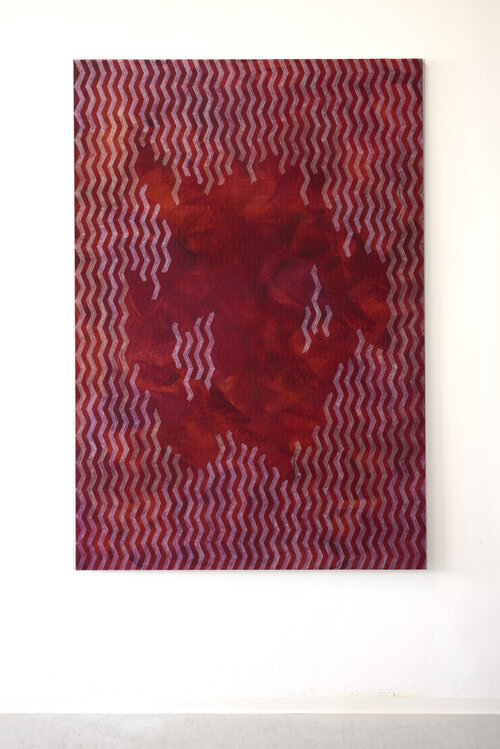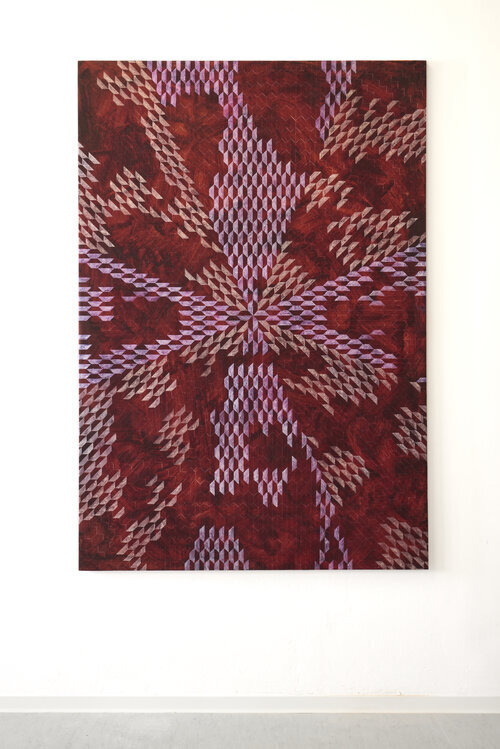Interview #83
Matthias Esch
Explore the ways Matthias Esch incorporates his personality and his emotions in his work
Matthias was born 1988 in Andernach, Germany (the origin of Charles Bukowski), but grew up in a small village 150km away from Cologne. For three years he made wine as an apprentice, before he moved to Berlin, where he started to paint and decided to study art.
After time in Kassel and Antwerp, he finished his Masters in Berlin in 2016, and a post graduate Master at the Glasgow School of Art in 2018.
Is there any particular message that you wish your viewers take from your paintings?
Not really no. For me it is important that my work has two sides, a personal one (where, after looking at all my work, you gain insight in me as well) and the conceptual basis. Both of them influence each other, they are intertwined and therefore provide many possible points of view. You can think about how language structures our reality, and how reality is structured through our perception. You can enjoy the body of the painting, its colours, think about the title, compare it to other works, and so on. Art has to stay open, there is not one, but many messages inside.
Also unfortunately I am not Wittgenstein so I can not provide an actual tool for people, helping to gain knowledge (through language). I am not sure if my work can help you to become more relaxed and subsequently happy, more free. Probably not, but who knows.
Also I am a bit egocentric, painting is important for my sanity, and after on image is done, frozen, I have to do it again.
Tell us about your work and your process.
Ideas can come from anywhere, lately I am highly interested in geometrical floor patterns in Italian churches, but there are so many lovely things, books, movies, and other art that can spark a starting point.
I walk around and absorb things, sometimes I make small scribblings in my notebook, forget them and at some point, they might be something for a painting.
Between painting sessions I prepare my stretchers by planing the edges, making them more sharp. And I use oil-primed linen, a material I am absolutely in love with!
Once a year I have a period where I make many small watercolour paintings, but besides them or the small scribblings, I draw and paint directly on the painting surface so there are not that many preparations necessary.
Then one thing leads to another, there are mistakes, repetition and failure. Sometimes I leave paintings alone for a while, or they have to be destroyed or modified. Thats a big part of my process I guess, repetition, continuation and destruction.
“The most important thing, the only important thing, is that the painting has to “work”, function! If it is not good enough, or does annoy me after a couple of weeks, I will destroy it. Though this can happen months later as well, I am not prudish when it comes to that. So you could say a painting is finished when it survives..”



What ideas do you explore in your practice?
I used to be very interested in the interaction between language and image, about what influence titles have on our perception and so on. The apparent contradictoriness for example between words and pictures, the constant gap that seems to hover between them.
Because of semantics I started thinking more about systems and symbols that surround us, about the interaction we have with them, with language, images and with other people.
I feel many times there is a distance we can not overcome.
Maybe it is present everywhere, a gap in apperception, in the mirror stage by Lacan, between the it and the self, and even if you are absolutely in love, you can never merge with that other person.
Words are an easy cover-up for this, they slip between us and the world, we use them to organize, we use them and they influence us.
So I am try to create free floating signifiers for this condition, our dependence on systems and structure. If you see language as a system in which we are, and from which we cannot escape, it was logic to think about systems in general. Structures in which we move, visible patterns in our surroundings, invisible ones in our behaviour.
Then there is painting as a visual language, which might be a positive manifestation of the gap: it is solid but fluid, always open for different interpretations.While I am interested in theoretical aspects like semantics, I am also very keen to the idea that by looking at my art you can look inside me as well. Like I mentioned before, there is always a personal aspect to the work; through titles, gesture, colour and the choice and development of the motive in general I inscribe my emotional subject into the art.
Lately I try to strengthen this subjective aspect. Because of recent events it feels more natural to use more existential or poetic titles, or combine my paintings with videos and other media. For an upcoming exhibition I will also provide an artist book with images of art, sources and photography from my archive.



